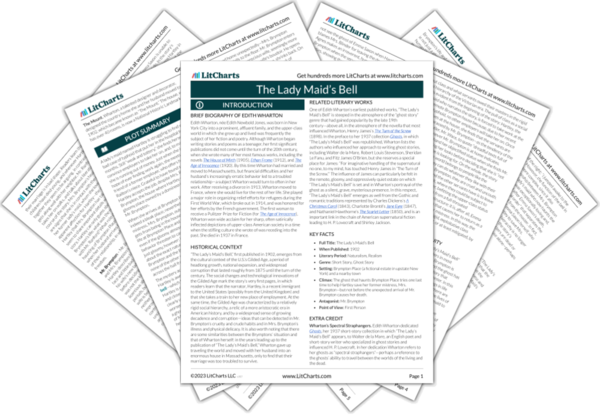Welcome to the LitCharts study guide on Edith Wharton's The Lady Maid’s Bell. Created by the original team behind SparkNotes, LitCharts are the world's best literature guides.
The Lady Maid’s Bell: Introduction
The Lady Maid’s Bell: Plot Summary
The Lady Maid’s Bell: Detailed Summary & Analysis
The Lady Maid’s Bell: Themes
The Lady Maid’s Bell: Quotes
The Lady Maid’s Bell: Characters
The Lady Maid’s Bell: Symbols
The Lady Maid’s Bell: Theme Wheel
Brief Biography of Edith Wharton

Historical Context of The Lady Maid’s Bell
Other Books Related to The Lady Maid’s Bell
- Full Title: The Lady’s Maid’s Bell
- When Published: 1902
- Literary Period: Naturalism, Realism
- Genre: Short Story, Ghost Story
- Setting: Brympton Place (a fictional estate in upstate New York) and a nearby town
- Climax: The ghost that haunts Brympton Place tries one last time to help Hartley save her former mistress, Mrs. Brympton—but not before the unexpected arrival of Mr. Brympton causes her death.
- Antagonist: Mr. Brympton
- Point of View: First Person
Extra Credit for The Lady Maid’s Bell
Wharton’s Spectral Straphangers. Edith Wharton dedicated Ghosts, her 1937 short-story collection in which “The Lady’s Maid’s Bell” appears, to Walter de la Mare, an English poet and short-story writer who specialized in ghost stories and influenced H. P. Lovecraft. In her dedication Wharton refers to her ghosts as “spectral straphangers”—perhaps a reference to the ghosts’ ability to travel between the worlds of the living and the dead.
The Mount. Wharton, a talented designer and decorator, designed the country home she and her husband moved to in 1902, which became known as “The Mount.” The house, which has over 40 rooms, is now a National Historic Landmark.












